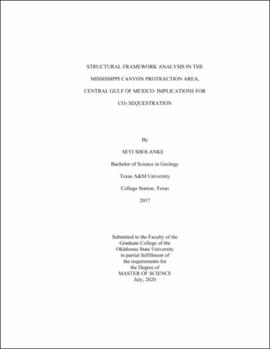| dc.contributor.advisor | Pashin, Jack | |
| dc.contributor.author | Sholanke, Seyi | |
| dc.date.accessioned | 2023-04-20T15:38:28Z | |
| dc.date.available | 2023-04-20T15:38:28Z | |
| dc.date.issued | 2020-07 | |
| dc.identifier.uri | https://hdl.handle.net/11244/337427 | |
| dc.description.abstract | Geologic factors such as faults and salt tectonics have implications for the reliability of CO2-Enhanced Oil Recovery (CO₂-EOR) and CO₂ sequestration targets in deep water reservoirs of the Gulf of Mexico. Salt-tectonic faults within withdrawal basins that serve as primary targets for CO₂ -EOR, can be either conduits or barriers for fluid flow. To understand the impacts of salt-related faults and other salt tectonic structures on potential CO₂ storage in deep water reservoirs, this study focuses on 1) identifying fields with CO₂-EOR potential and associated storage, and 2) characterizing salt systems, faults, folds, minibasins and associated hydrocarbon traps and CO₂ sinks. The analysis focuses on salt tectonics to develop an understanding of its potential impact on the stratal geometry of candidate reservoirs for carbon sequestration. The structural and stratigraphic framework within the study area was analyzed by integrating wireline logs, biostratigraphic information, and 3-D seismic data. | |
| dc.description.abstract | The structural framework in the Mississippi Canyon area comprises an array of growth faults and decollements that separate distinct depositional objectives. Salt canopies, diapirs, rollers, allochthonous sheets, pillows, withdrawal synclines, anticlines, and roho structures have been interpreted and mapped. Basinward dipping listric growth faults have also been identified. Listric normal faults cut siliciclastic seal and reservoir strata. Faults above salt canopies are extensional, and remnant salt rollers are present in roho complexes. Sets of growth faults superimposed on salt sheets were identified. The Mississippi Canyon protraction area contains laterally continuous sandstone reservoirs that are overlain by thick and regionally correlated sections of shale, and sandstone that form effective seals. Minibasins are potential storage objectives that result from salt withdrawal. Other objectives are salt seals in the footwalls of some faults and strata that are truncated below allochthonous salt wings | |
| dc.format | application/pdf | |
| dc.language | en_US | |
| dc.rights | Copyright is held by the author who has granted the Oklahoma State University Library the non-exclusive right to share this material in its institutional repository. Contact Digital Library Services at lib-dls@okstate.edu or 405-744-9161 for the permission policy on the use, reproduction or distribution of this material. | |
| dc.title | Structural framework analysis in the Mississippi Canyon protraction area, Central Gulf of Mexico: Implications for CO₂ sequestration | |
| dc.contributor.committeeMember | Puckette, Jim | |
| dc.contributor.committeeMember | Abdelsalam, Mohamed | |
| osu.filename | SHOLANKE_okstate_0664M_16892.pdf | |
| osu.accesstype | Open Access | |
| dc.type.genre | Thesis | |
| dc.type.material | Text | |
| thesis.degree.discipline | Geology | |
| thesis.degree.grantor | Oklahoma State University | |
